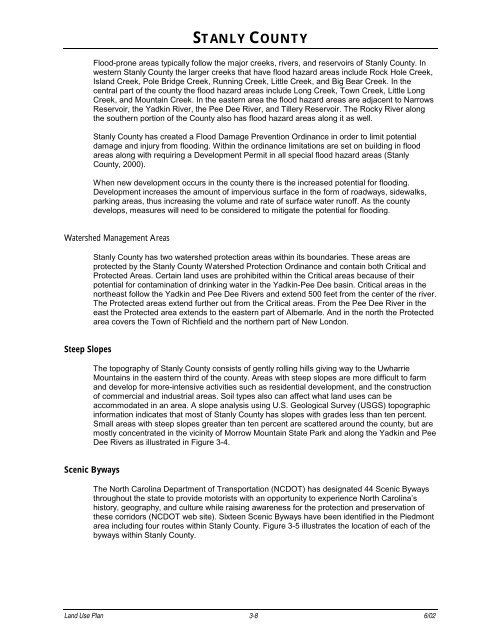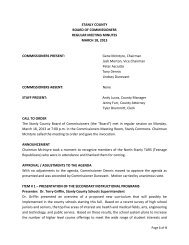Land Use Plan – 2002 - Stanly County, North Carolina
Land Use Plan – 2002 - Stanly County, North Carolina
Land Use Plan – 2002 - Stanly County, North Carolina
You also want an ePaper? Increase the reach of your titles
YUMPU automatically turns print PDFs into web optimized ePapers that Google loves.
STANLY COUNTY<br />
Flood-prone areas typically follow the major creeks, rivers, and reservoirs of <strong>Stanly</strong> <strong>County</strong>. In<br />
western <strong>Stanly</strong> <strong>County</strong> the larger creeks that have flood hazard areas include Rock Hole Creek,<br />
Island Creek, Pole Bridge Creek, Running Creek, Little Creek, and Big Bear Creek. In the<br />
central part of the county the flood hazard areas include Long Creek, Town Creek, Little Long<br />
Creek, and Mountain Creek. In the eastern area the flood hazard areas are adjacent to Narrows<br />
Reservoir, the Yadkin River, the Pee Dee River, and Tillery Reservoir. The Rocky River along<br />
the southern portion of the <strong>County</strong> also has flood hazard areas along it as well.<br />
<strong>Stanly</strong> <strong>County</strong> has created a Flood Damage Prevention Ordinance in order to limit potential<br />
damage and injury from flooding. Within the ordinance limitations are set on building in flood<br />
areas along with requiring a Development Permit in all special flood hazard areas (<strong>Stanly</strong><br />
<strong>County</strong>, 2000).<br />
When new development occurs in the county there is the increased potential for flooding.<br />
Development increases the amount of impervious surface in the form of roadways, sidewalks,<br />
parking areas, thus increasing the volume and rate of surface water runoff. As the county<br />
develops, measures will need to be considered to mitigate the potential for flooding.<br />
Watershed Management Areas<br />
Steep Slopes<br />
<strong>Stanly</strong> <strong>County</strong> has two watershed protection areas within its boundaries. These areas are<br />
protected by the <strong>Stanly</strong> <strong>County</strong> Watershed Protection Ordinance and contain both Critical and<br />
Protected Areas. Certain land uses are prohibited within the Critical areas because of their<br />
potential for contamination of drinking water in the Yadkin-Pee Dee basin. Critical areas in the<br />
northeast follow the Yadkin and Pee Dee Rivers and extend 500 feet from the center of the river.<br />
The Protected areas extend further out from the Critical areas. From the Pee Dee River in the<br />
east the Protected area extends to the eastern part of Albemarle. And in the north the Protected<br />
area covers the Town of Richfield and the northern part of New London.<br />
The topography of <strong>Stanly</strong> <strong>County</strong> consists of gently rolling hills giving way to the Uwharrie<br />
Mountains in the eastern third of the county. Areas with steep slopes are more difficult to farm<br />
and develop for more-intensive activities such as residential development, and the construction<br />
of commercial and industrial areas. Soil types also can affect what land uses can be<br />
accommodated in an area. A slope analysis using U.S. Geological Survey (USGS) topographic<br />
information indicates that most of <strong>Stanly</strong> <strong>County</strong> has slopes with grades less than ten percent.<br />
Small areas with steep slopes greater than ten percent are scattered around the county, but are<br />
mostly concentrated in the vicinity of Morrow Mountain State Park and along the Yadkin and Pee<br />
Dee Rivers as illustrated in Figure 3-4.<br />
Scenic Byways<br />
The <strong>North</strong> <strong>Carolina</strong> Department of Transportation (NCDOT) has designated 44 Scenic Byways<br />
throughout the state to provide motorists with an opportunity to experience <strong>North</strong> <strong>Carolina</strong>’s<br />
history, geography, and culture while raising awareness for the protection and preservation of<br />
these corridors (NCDOT web site). Sixteen Scenic Byways have been identified in the Piedmont<br />
area including four routes within <strong>Stanly</strong> <strong>County</strong>. Figure 3-5 illustrates the location of each of the<br />
byways within <strong>Stanly</strong> <strong>County</strong>.<br />
<strong>Land</strong> <strong>Use</strong> <strong>Plan</strong> 3-8 6/02






